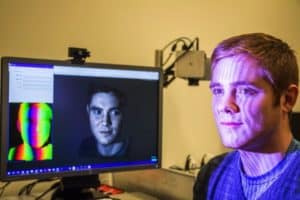
Thanks to technologies like the depth sensor on an iPhone X, 3D imaging is truly mainstream. But recording holographic images and displaying them are two very different questions. In short: We have plenty of ways of easily carrying out the former, but very much of the latter. This is where researchers from Purdue University’s School of Mechanical Engineering think they can help.
They developed a new platform, named “Holostream,” which enables high-quality 3D video communication on mobile devices, using only existing standard wireless networks. Imagine a three-dimensional version of Skype, where you can rotate the image in real time, and you pretty much have the idea.
“The Holostream system includes four major modules,” Song Zhang, an associate professor at Purdue, told Digital Trends. “[There’s] a high-accuracy and high-resolution 3D video acquisition module that achieves camera pixel resolution at 30Hz; a novel 3D video compression module that substantially reduces 3D video data size; a 3D video streaming module that delivers compressed 3D video contents and decompresses the videos in real time; and 3D video visualization modules that allows the mobile device users to naturally access and interact with high-quality 3D video contents in real time at a remote location across standard networks.”
As Zhang explains, Holostream could be used for a variety of applications. For example, it’s easy to imagine it being used as a communication or messaging tool that could appeal to users once the thrill of iOS 11’s Animojis wears off. But it could also have more serious, game-changing uses — like being utilized in telemedicine or remote collaborative design.
“I am interested in making this technology commercially available,” Zhang said. To reach this point, however, the team needs to carry out more work on their 3D video compression algorithms to ensure that they are compressing low-quality 3D video data in the most effective way. Since different applications will require different levels of detail in the 3D images, this is an important part of the project.
The research carried out by Zhang’s team will be presented at the Electronic Imaging 2018 conference, running from January 28 to February 2 in Burlingame, California. Hopefully, it won’t be too long after that before we get to put it through its paces. Skype and FaceTime are seemingly boringly two-dimensional already!


